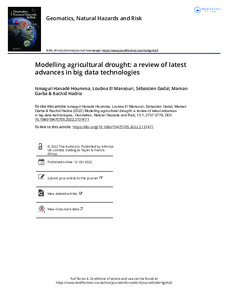| dc.contributor.author | Houmma, I.H. |
| dc.contributor.author | El Mansouri, L. |
| dc.contributor.author | Gadal, S. |
| dc.contributor.author | Garba, M. |
| dc.contributor.author | Hadria, R. |
| dc.date.accessioned | 2022-10-26T10:50:29Z |
| dc.date.available | 2022-10-26T10:50:29Z |
| dc.date.issued | 2022 |
| dc.identifier.citation | Houmma, I.H., El Mansouri, L., Gadal, S., Garba, M. & Hadria, R. (2022). Modelling agricultural drought: a review of latest advances in big data technologies. Geomatics, Natural Hazards and Risk, 13(1), 2737-2776. |
| dc.identifier.issn | 1947-5705 |
| dc.identifier.uri | https://hdl.handle.net/20.500.12478/7910 |
| dc.description.abstract | This article reviews the main recent applications of multi-sensor remote sensing and Artificial Intelligence techniques in multivariate modelling of agricultural drought. The study focused mainly on three fundamental aspects, namely descriptive modelling, predictive modelling, and spatial modelling of expected risks and vulnerability to drought. Thus, out of 417 articles across all studies on drought, 226 articles published from 2010 to 2022 were analyzed to provide a global overview of the current state of knowledge on multivariate drought modelling using the inclusion criteria. The main objective is to review the recent available scientific evidence regarding multivariate drought modelling based on the joint use of geospatial technologies and artificial intelligence. The analysis focused on the different methods used, the choice of algorithms and the most relevant variables depending on whether they are descriptive or predictive models. Criteria such as the skill score, the given game complexity used, and the nature of validation data were considered to draw the main conclusions. The results highlight the very heterogeneous nature of studies on multivariate modelling of agricultural drought, and the very original nature of studies on multivariate modelling of agricultural drought in the recent literature. For future studies, in addition to scientific advances in prospects, case studies and comparative studies appear necessary for an in-depth analysis of the reproducibility and operational applicability of the different approaches proposed for spatial and temporal modelling of agricultural drought. |
| dc.description.sponsorship | Islamic Development Bank |
| dc.format.extent | 2737-2776 |
| dc.language.iso | en |
| dc.subject | Modelling |
| dc.subject | Drought |
| dc.subject | Machine Learning |
| dc.subject | Artificial Intelligence |
| dc.title | Modelling agricultural drought: a review of latest advances in big data technologies |
| dc.type | Journal Article |
| cg.contributor.affiliation | Universite Cote d‘Azur |
| cg.contributor.affiliation | Institute of Agronomy and Veterinary, Morocco |
| cg.contributor.affiliation | North-Eastern Federal University, Republic of Sakha-Yakutia |
| cg.contributor.affiliation | International Institute of Tropical Agriculture |
| cg.contributor.affiliation | Institut National de la Recherche Agronomique du Niger |
| cg.contributor.affiliation | National Institute of Agricultural Research, Morocco |
| cg.coverage.hub | Headquarters and Western Africa Hub |
| cg.identifier.bibtexciteid | HOUMMA:2022 |
| cg.isijournal | ISI Journal |
| cg.authorship.types | CGIAR and developing country institute |
| cg.iitasubject | Food Security |
| cg.iitasubject | Smallholder Farmers |
| cg.journal | Geomatics, Natural Hazards and Risk |
| cg.notes | Open Access Article; Published online: 12 Oct 2022 |
| cg.accessibilitystatus | Open Access |
| cg.reviewstatus | Peer Review |
| cg.usagerightslicense | Creative Commons Attribution 4.0 (CC BY 0.0) |
| cg.targetaudience | Scientists |
| cg.identifier.doi | https://dx.doi.org/10.1080/19475705.2022.2131471 |
| cg.futureupdate.required | No |
| cg.identifier.issue | 1 |
| cg.identifier.volume | 13 |
| cg.contributor.acknowledgements | We gratefully thank the following research structures: the laboratory (UR 18) of the Department of Geodesy and Topography (IAV Hassan II), the laboratory of UMR CNRS ESPACE 7300 (AMU France), and the Regional Center for Agronomic Research of Marrakech (INRA, Morocco) for their contributions and collaborations in this research. We also thank the Islamic Development Bank for its financial support (scholarship). We extend our thanks and appreciation to the editor of Geomatics, Natural Hazards, and Risk Journal and the reviewers for their valuable comments and recommendations. |

